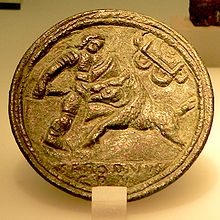Venatio

Venatio(Latin:venatio,"hunting", pluralvenationes) was a type of entertainment inRomanamphitheatersinvolving the hunting and killing ofwild animals.
History
[edit]Venatio was first introduced byMarcus Fulvius Nobilior,who celebrated his Greek campaign by hosting games where gladiators would fight lions and panthers.
Exotic wild beasts from the far reaches of theRoman Empirewere brought to Rome and hunts were held in the morning prior to the afternoon main event ofgladiatorialduels. The hunts were held in theRoman Forum,theSaepta,and in theCircus Maximus,though none of these venues offered protection to the crowd from the wild animals on display. Special precautions were taken to prevent the animals from escaping these venues, such as the erection of barriers and the digging of ditches. Very few animals survived these hunts though they did sometimes defeat the "bestiarius",or hunter of wild beast. Thousands of wild animals would be slaughtered in one day. During theInaugural games of the Flavian Amphitheatre(80), about 9,000 animals were killed.[1]

Not all the animals were ferocious, though most were. Animals that appeared in the venatio includedlions,elephants,bears,tigers,[2]deer,cows,wolverines,zebras,ostriches,vultures,weasels,polecats,minks,giraffes,eagles,wildgoats,parrots,dogs,camels,monkeys,wolves,jackals,foxes,leopards,crocodiles,boars,hippos,[3]andrabbits.[4]Other animals appeared in the venatio includedcheetahs,rhinos,gazelles,snakes,horses,hyenas,andgorillas.Some of these animals were trained, and instead of fighting, performed tricks.
The treatment given to wolves differed from the treatment meted out to other large predators. The Romans generally seem to have refrained from intentionally harming wolves. For instance, they were not displayed in the venationes due to their religious importance to the Romans.[5]
Revered for its ferocity, the lion was extremely popular in venationes and gladiatorial shows. Thus the dictatorCaesarused 400 lions (imported primarily fromNorth AfricaandSyria) in the Circus, where the inclusion of the foreign animal lent his shows extra panache. Indeed, obtaining the animals from the far-flung corners of the empire was an ostentatious display of wealth and power by the emperor or other patron to the populace, and was also meant to demonstrate Roman power of the whole human and animal world and to show theplebsof Rome exotic animals they might never see otherwise.
During the reign ofAugustus Caesarthe circus games resulted in the death of 3,500elephants.[6]
Executions
[edit]Following the venatio in the order of daily events was theexecutionof convictedRoman citizensof lower status, thehumiliores.Usual forms of execution includedburning at the stake,crucifixion,orad bestias(when the prisoner is left alone in the ring with one or more wild animals).
Roman emperors often sentenced serious criminals — who then became known asbestiarii— to fatal encounters with the beasts in the Colosseum — an ancient "death sentence".[7]These were the lowestsocial classof participants in the games.[8]
See also
[edit]References
[edit]- ^pg 105 ofThe Gladiator,by Alan Baker, Ebury PressISBN0-09-188654-6
- ^Auguet, Roland (1994). Cruelty and civilization: the Roman games. Psychology Press. pp. 83–85.ISBN978-0-415-10453-1.
- ^Christesen, Paul;Kyle, Donald G.. (2013).Companion to Sport and Spectacle in Greek and Roman Antiquity, A.Wiley-Blackwell. Retrieved 5 December 2017, fromhttp://www.myilibrary.com?ID=543132
- ^Martin Wainwright (7 June 2010)."Scars from lion bite suggest headless Romans found in York were gladiators".The Guardian.
- ^Mika Rissanen."Was There a Taboo on Killing Wolves in Rome?".Quaderni Urbinati di Cultura Classica.Fabrizio Serra Editore.Retrieved2016-03-28.
- ^Greg Woolf (2007).Ancient civilizations: the illustrated guide to belief, mythology, and art.Barnes & Noble. p. 397.ISBN978-1-4351-0121-0.
- ^The Bestiarius and the Ludus Matutinus
- ^"Ad Bestias".Retrieved2009-03-26.
